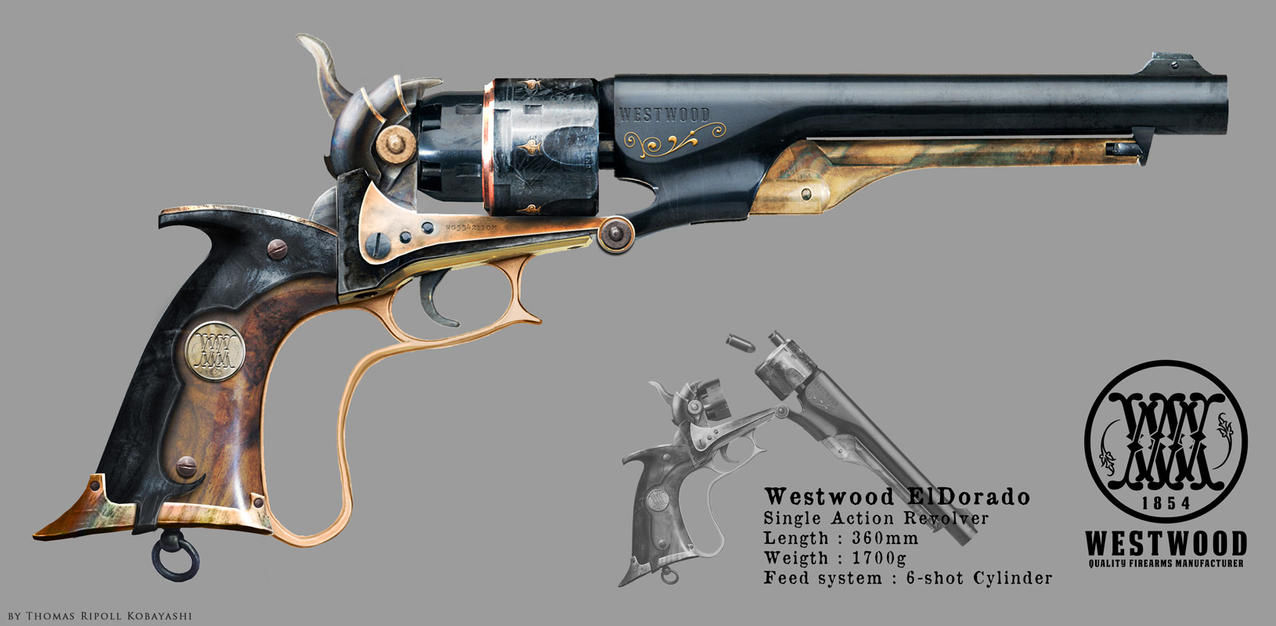
This Gun just goes to show that some folks have way too much time & money on their hands. But if it lets them sleep well at night and they do not cause problems.
So as I like to think That I am a good American. Then All I can say is Good luck and God Bless them!
So here are a few more for your education and benefit.

I think That is a French “Apache Gang type Toy” I saw one of these in Montenegro.(yes there is such a place!)
I saw one of these in Montenegro.(yes there is such a place!)
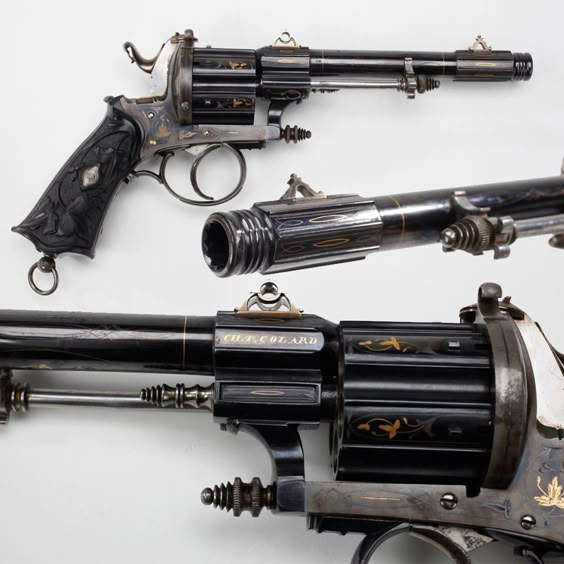

Anybody have an idea what this Semi Auto use to be?

 Hopefully this one is just a concept drawing! But I wonder what it’s power source is?
Hopefully this one is just a concept drawing! But I wonder what it’s power source is?

Category: All About Guns







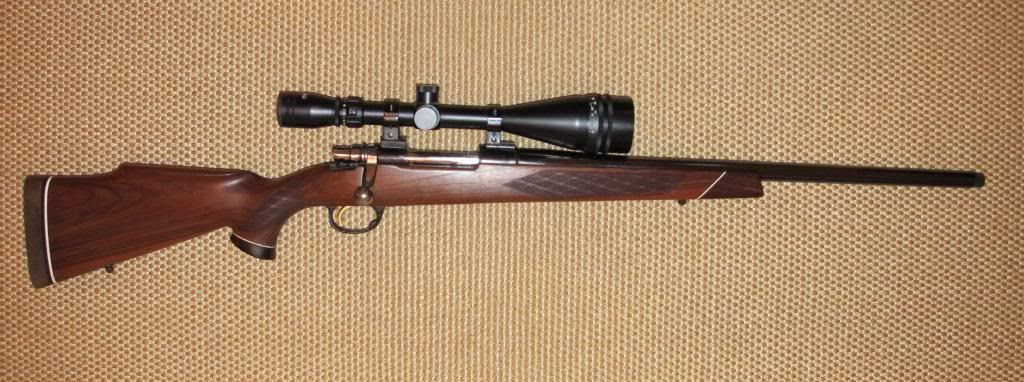
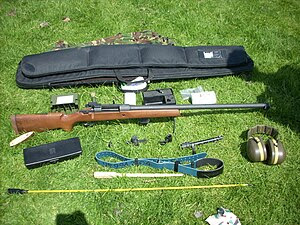 (It use to be a lot of Police Departments used this rifle for its SWAT Team Sniper.)
(It use to be a lot of Police Departments used this rifle for its SWAT Team Sniper.)


Previous gun manufacturer located in Birmingham, England. Rifles were manufactured in England until 1991 when Navy Arms purchased the manufacturing rights and built a plant in West Virginia for fabrication. This new company was called Gibbs Rifle Company, Inc. and they manufactured models very similar to older Parker-Hale rifles during 1992-94. Shotguns were manufactured in Spain and imported by Precision Sports, a division of Cortland Line Company, Inc. located in Cortland, NY until 1993.
Parker was the previous trade name of the A.G. Parker Company, located in Birmingham, England, which was formed from a gun making business founded in 1890 by Alfred Gray Parker. The company became the Parker-Hale company in 1936. The company was purchased by John Rothery Wholesale circa 2000.
Parker-Hale Ltd. continues to make a wide variety of high quality firearms cleaning accessories for both rifles and shotguns, including their famous bipod.
Now I have met and known a few of these folks over the years. Most of them are pretty good guys to have around. Just do not piss them off or let them near your Female friend and relatives. Just saying.
Now most of the time. They are armed with the standard issue weapons of the time. Which have ranged from the Brown Bess of the French & Indian War. Up to today’s Army weaponry.
But one of the trade marks of these folks is their love of sharp thing from Tomahawks, Trench Knives to Chain Saws. (I am not kidding about that one! I saw it myself at Camp Ripley )


The Early Days


Korean War


Vietnam

Guns used in Vietnam
the 1980’s

Today in the Field


United States Army Rangers
|
|
This article has an unclear citation style. (May 2015) (Learn how and when to remove this template message) |
| United States Army Rangers | |
|---|---|
 |
|
| Active | 1942–present |
| Country | |
| Allegiance | United States of America |
| Branch | |
| Type | Light infantry |
| Role | Special operations |
| Size | 3,623 personnel authorized:[1]
|
| Garrison/HQ | Fort Benning, Georgia Fort Lewis, Washington Hunter Army Airfield, Georgia |
| Motto(s) | Sua Sponte (Of Their Own Accord): (75th Ranger Regiment) Rangers Lead the Way: (Army Ranger-qualified soldiers) |
| Engagements | American Revolutionary War War of 1812 Black Hawk War Civil War World War I World War II Korean War Vietnam War Operation Eagle Claw Grenada Panama Gulf War Operation Gothic Serpent Kosovo War Iraq War War in Afghanistan |
The United States Army Rangers are an elite rapid-deploymentmilitary formation of the United States Army, that serve in designated U.S. Army Ranger units or are graduates from the U.S. Army Ranger School.[2] The term ranger has been in use unofficially in a military context since the early 17th century. The first military company officially commissioned as rangers were English soldiers fighting in King Philip’s War (1676) and from there the term came into common official use in the French and Indian Wars. There have been American military companies officially called Rangers since the American Revolution.
The 75th Ranger Regiment is an elite airborne light infantry combat formation within the United States Army Special Operations Command (USASOC). The six battalions of the modern Rangers have been deployed in wars in Korea, Vietnam, Afghanistan, and Iraq, and saw action in several conflicts, such as those in Panamaand Grenada. The Ranger Regiment traces its lineage to three of six battalions raised in World War II, and to the 5307th Composite Unit (Provisional)—known as “Merrill’s Marauders“, and then reflagged as the 475th Infantry, then later as the 75th Infantry.
The Ranger Training Brigade (RTB)—headquartered at Fort Benning—is an organization under the U.S. Army’s Training and Doctrine Command (TRADOC) and is separate from the 75th Ranger Regiment. It has been in service in various forms since World War II. The Ranger Training Brigade administrates Ranger School, the satisfactory completion of which is required to become Ranger qualified and to wear the Ranger Tab.
Contents
[hide]
Colonial period[edit]

Colonel Benjamin Church: Father of American Ranging
Rangers served in the 17th and 18th-century wars between colonists and Native American tribes. The British regulars were not accustomed to frontier warfare and so Ranger companies were developed. Rangers were full-time soldiers employed by colonial governments to patrol between fixed frontier fortifications in reconnaissance providing early warning of raids. In offensive operations, they were scouts and guides, locating villages and other targets for taskforces drawn from the militia or other colonial troops.
In Colonial America, “The earliest mention of Ranger operations comes from Capt. John “Samuel” Smith,” who wrote in 1622, “When I had ten men able to go abroad, our common wealth was very strong: with such a number I ranged that unknown country 14 weeks.”[3] Robert Black also stated that,
In 1622, after the Berkeley Plantation Massacre … grim-faced men went forth to search out the Indian enemy. They were militia—citizen soldiers—but they were learning to blend the methods of Indian and European warfare…As they went in search of the enemy, the words range, ranging and Ranger were frequently used … The American Ranger had been born.[4]
The father of American ranging is Colonel Benjamin Church (c. 1639–1718).[5] He was the captain of the first Ranger force in America (1676).[5]:33 Church was commissioned by the Governor of the Plymouth Colony Josiah Winslow to form the first ranger company for King Philip’s War. He later employed the company to raid Acadia during King William’s War and Queen Anne’s War.
Benjamin Church designed his force primarily to emulate Native American patterns of war. Toward this end, Church endeavored to learn to fight like Native Americans from Native Americans.[5]:35 Americans became rangers exclusively under the tutelage of the Indian allies. (Until the end of the colonial period, rangers depended on Indians as both allies and teachers.)[5]:34–35
Church developed a special full-time unit mixing white colonists selected for frontier skills with friendly Native Americans to carry out offensive strikes against hostile Native Americans in terrain where normal militia units were ineffective. His memoirs Entertaining Passages relating to Philip’s War is considered the first American military manual (published 1716).[citation needed]
Under Church served the father and grandfather of two famous rangers of the eighteenth century: John Lovewell and John Gorham respectively.[5]:38 John Lovewell served during Dummer’s War (also known as Lovewell’s War). He lived in present-day Nashua, New Hampshire. He fought in Dummer’s War as a militia captain, leading three expeditions against the Abenaki Indians. John Lovewell became the most famous Ranger of the eighteenth century.[5]:50
During King George’s War, John Gorham established “Gorham’s Rangers”. Gorham’s company fought on the frontier at Acadia and Nova Scotia. Gorham was commissioned a captain in the regular British Army in recognition of his outstanding service. He was the first of three prominent American rangers–himself, his younger brother Joseph Gorham and Robert Rogers—to earn such commissions in the British Army. (Many others, such as George Washington, were unsuccessful in their attempts to achieve a British rank.)[5]:76
Rogers’ Rangers was established in 1751[6] by Major Robert Rogers, who organized nine Ranger companies in the American colonies. These early American light infantry units, organized during the French and Indian War, bore the name “Rangers” and were the forerunners of the modern Army Rangers. Major Rogers drafted the first currently-known set of standard orders for rangers. These rules, Robert Rogers’ 28 “Rules of Ranging”, are still provided to all new Army Rangers upon graduation from training, and served as one of the first modern manuals for asymmetric warfare.
American Revolution[edit]
When the American Revolution began, Major Robert Rogers allegedly offered his services to General George Washington.[citation needed] Fearing that Rogers was a spy, Washington refused. An incensed Rogers instead joined forces with the Loyalists and fought for the crown. While serving with the British, Col. Rogers was responsible for capturing America’s most famous spy in Nathan Hale. Not all of Rogers’ Rangers went with him, however, including such notable figures as Israel Putnam.[citation needed] Later on during the war, General Washington ordered Lieutenant Colonel Thomas Knowlton to select an elite group of men for reconnaissance missions. This unit was known as Knowlton’s Rangers, and is credited as the first official Ranger unit (by name) for the United States. This unit, however, carried out intelligence functions rather than combat functions in most cases, and as such are not generally considered the historical parent of the modern day Army Rangers. Instead, Knowlton’s Rangers gave rise to the modern Military Intelligence branch (although it was not a distinct branch until the 20th century).[citation needed]
Francis Marion, the “Swamp Fox” Revolutionary commander of South Carolina, developed irregular methods of warfare against the British army. As one of the fathers of modern guerrilla warfare, he is credited in the lineage of the Army Rangers, as is George Rogers Clark who led an irregular force of Kentucky/Virginia militiamen to capture the Bristish forts at Vincennes and Kaskaskia, Illinois.
War of 1812[edit]
In January 1812 the United States authorized six companies of United States Rangers who were mounted infantry with the function of protecting the Western frontier. Five of these companies were raised in Ohio, Indiana, Illinois and Kentucky. A sixth was in Middle Tennessee, organized by Capt. David Mason.[7] The next year, 10 new companies were raised. By December 1813 the Army Register listed officers of 12 companies of Rangers.[8] The Ranger companies were discharged in June 1815.
Black Hawk War[edit]
During the Black Hawk War, in 1832, the United States Mounted Ranger Battalion, an early version of the cavalry in the U.S. Army was created out of frontiersmen who enlisted for one year and provided their own rifles and horses. The battalion was organized into six companies of 100 men each that was led by Major Henry Dodge. After their enlistment expired there was no creation of a second battalion.[9] Instead, the battalion was reorganized into the 1st Dragoon Regiment.
American Civil War[edit]
The most famous Rangers of the American Civil War fought for the Confederate States Army. In January 1863, John S. Mosby was given command of the 43rd Battalion, Partisan Rangers, a fast-striking cavalry unit. Mosby’s Rangers became infamous among Union soldiers due to their frequent raids on supply trains and couriers. Mosby believed that by resorting to aggressive action he could compel his enemies to guard a hundred points. He would then attack one of the weakest points and be assured numerical superiority. Their reputation was heightened when Mosby and 29 of his Rangers performed a raid deep into Union territory on March 9, 1863, and captured Brigadier General Edwin H. Stoughton and two other officers.[10] Weeks after the surrender of the Confederate Army Mosby disbanded his unit rather than formally surrender.[11]
Another Virginian Confederate commander, Turner Ashby, led an irregular cavalry unit known as the Mountain Rangers, who became known for their ability to harass Union soldiers. Terry’s Texas Rangers was another famous Confederate cavalry force which incorporated ranger tactics, as did similar units led by John Hunt Morgan, J.E.B. Stuart, and Nathan Bedford Forrest. Because of the daring exploits and intrepidity of these Confederate rangers, the Confederate Battle flag was incorporated into the official Ranger crest and insignia for many years, until a modern revision replaced it.
The most successful attacks against Mosby’s Rangers were carried out by the Union Army’s Mean’s Rangers. Mean’s Rangers became famous when they successfully captured General James Longstreet‘s ammunition train. They later fought and captured a portion of Mosby’s force.
World War II[edit]
Major General Lucian Truscott of the U.S. Army was a liaison officer with the British General Staff. In 1942 he submitted a proposal to General George Marshall that an American unit be set up “along the lines of the British Commandos“.
European theater[edit]
On June 19, 1942 the 1st Ranger Battalion was sanctioned, recruited, and began training in Carrickfergus, Northern Ireland.[12] 80 percent of the original Rangers came from the 34th Infantry Division.
A select fifty or so of the first U.S. Rangers were dispersed through the British Commandos for the Dieppe Raid in August 1942; these were the first American soldiers to see ground combat in the European theater.
Together with the ensuing 3rd and 4th Ranger Battalions they fought in North Africa and Italy commanded by Colonel William Orlando Darby until the Battle of Cisterna (29 January 1944) when most of the Rangers of the 1st and 3rd Battalions were captured. Of the 767 men in the battalions 761 were killed or captured. The remaining Rangers were absorbed into the Canadian-American First Special Service Force under Brigadier General Robert T. Frederick. They were then instrumental in operations in and around the Anzio beachhead that followed Operation Shingle.[13]

D-Day, Pointe du Hoc
The 29th Ranger Battalion was a temporary unit made of selected volunteers from the 29th Infantry Division that was in existence from December 1942 to November 1943.
Before the 5th Ranger Battalion landing on Dog White sector on Omaha Beach, during the Invasion of Normandy, the 2nd Ranger Battalion scaled the 90-foot (27 m) cliffs of Pointe du Hoc, a few miles to the west, to destroy a five-gun battery of captured French Canon de 155 mm GPF guns. The gun positions were empty on the day and the weapons had been removed some time before to allow the construction of casements in their place. (one of the gun positions was destroyed by the RAF in May—prior to D-day—leaving 5 missing guns).[14] Under constant fire during their climb, they encountered only a small company of Germans on the cliffs and subsequently discovered a group of field artillery weapons in trees some 1,000 yards (910 m) to the rear. The guns were disabled and destroyed, and the Rangers then cut and held the main road for two days before being relieved. All whilst being reinforced by members of the 5th Ranger Battalion who arrived at 6pm on the 6th of June from Omaha Beach. More 5th Ranger units arrived by sea on the 7th of June when some of their wounded along with German prisoners were taken away to the waiting ships.[15]
Currently no memorial exists at Pointe du Hoc to commemorate the actions of the 5th Rangers at Pointe du Hoc—only one to the members of the 2nd Battalion. However, the American Battle Monuments Commission (ABMC) have said that they will correct this error in the near future. The 5th Rangers along with members of the 2nd Btn (with 2 × 75 mm mobile half tracks) then went on to attack the Maisy battery which was still firing on both Omaha and Utah beaches. The 23 members of the 5th Battalion who reached and re-enforced the 2nd Battalion men at Pointe du Hoc on the 6th of June won the Presidential Unit Citation for the 5th Rangers—for the “Deepest penetration of any combat unit on D-day”.[citation needed] Major Richard Sullivan (officer commanding) won the Distinguished Service Cross for three actions in Normandy: the landings on Omaha Beach, the relief of Point du Hoc and the successful capture of the Maisy Battery.
Pacific theater[edit]
Two separate Ranger units fought the war in the Pacific Theater. The 98th Field Artillery Battalion was formed on 16 December 1940 and activated at Fort Lewis in January 1941. On 26 September 1944, they were converted from field artillery to light infantry and became 6th Ranger Battalion. 6th Ranger Battalion led the invasion of the Philippines and executed the raid on the Cabanatuan POW camp.[16][17] They continued fighting in the Philippines until they were deactivated on 30 December 1945, in Japan.
After the first Quebec Conference, the 5307th Composite Unit (provisional) was formed with Frank Merrill as the commander, its 2,997 officers and men became popularly known as Merrill’s Marauders. They began training in India on 31 October 1943. Much of the Marauders training was based on Major General Orde Wingateof the British Army who specialized in deep penetration raids behind Japanese lines. The 5307th Composite Group was composed of the six color-coded combat teams that would become part of modern Ranger heraldry, they fought against the Japanese during the Burma Campaign. In February 1944, the Marauders began a 1,000-mile (1,600 km) march over the Himalayan mountain range and through the Burmese jungle to strike behind the Japanese lines. By March, they had managed to cut off Japanese forces in Maingkwan and cut their supply lines in the Hukawng Valley. On 17 May, the Marauders and Chinese forces captured the Myitkyina airfield, the only all-weather airfield in Burma. For their actions, every member of the unit received the Bronze Star.[18]
Motto[edit]
On 6 June 1944, during the assault landing on Dog White sector of Omaha Beach as part of the invasion of Normandy, then-Brigadier General Norman Cota (assistant CO of the 29th ID) approached Major Max Schneider, CO of the 5th Ranger Battalion and asked “What outfit is this?”, Schneider answered “5th Rangers, Sir!” To this, Cota replied “Well, goddamnit, if you’re Rangers, lead the way!” From this, the Ranger motto—”Rangers lead the way!”—was born.[19]
Korean War[edit]
At the outbreak of the Korean War, a unique Ranger unit was formed. Led by Second Lieutenant Ralph Puckett, the Eighth Army Ranger Company was created in August 1950. It served as the role model for the rest of the soon to be formed Ranger units. Instead of being organized into self-contained battalions, the Ranger units of the Korean and Vietnam eras were organized into companies and then attached to larger units, to serve as organic special operations units.
In total, sixteen additional Ranger companies were formed in the next seven months: Eighth Army Raider Company and First through Fifteenth Ranger Company. The Army Chief of Staff assigned the Ranger training program at Fort Benning to Colonel John Gibson Van Houten. The program eventually split to include a training program located in Korea. 3rd Ranger Company and the 7th Ranger Company were tasked to train new Rangers.[20]
The next four Ranger companies were formed 28 October 1950. Soldiers from the 505th Airborne Regiment and the 82nd Airborne‘s 80th Anti-aircraft Artillery Battalion volunteered and, after initially being designated the 4th Ranger Company, became the 2nd Ranger Company—the only all-black Ranger unit in United States history. After the four companies had begun their training, they were joined by the 5th–8th Ranger companies on 20 November 1950.
During the course of the war, the Rangers patrolled and probed, scouted and destroyed, attacked and ambushed the Communist Chinese and North Korean enemy. The 1st Rangers destroyed the 12th North Korean Division headquarters in a daring night raid. The 2nd and 4th Rangers made a combat airborne assault near Munsan where Life Magazine reported that Allied troops were now patrolling north of the 38th Parallel. Crucially, the 2nd Rangers plugged the gap made by the retreating Allied forces, the 5th Ranger Company helped stop the Chinese 5th Phase Offensive. As in World War II, after the Korean War, the Rangers were disbanded.
Vietnam War[edit]
Long Range Reconnaissance Patrol (LRRP) and Long Range Patrol companies (commonly known as Lurps) were formed by the U.S. Army in the early 1960s in West Germany to provide small, heavily armed reconnaissance teams to patrol deep in enemy-held territory in case of war with the Soviet Union and its Warsaw Pact allies.[21][22]
In Vietnam LRRP platoons and companies were attached to every brigade and division where they perfected the art of long-range patrolling.[21] Since satellite communications were a thing of the future, one of the most daring long-range penetration operations of the Vietnam War was launched on April 19, 1968, by members of the 1st Air Cavalry Division‘s, Company E, 52nd Infantry (LRP), (redesignated Co. H, Ranger), against the NVA when they seized “Signal Hill” the name attributed to the peak of Dong Re Lao Mountain, a densely forested 4,879-foot (1,487 m) mountain, midway in A Shau Valley, so the 1st and 3rd Brigades, slugging it out hidden deep behind the towering wall of mountains, could communicate with Camp Evans near the coast or with approaching aircraft.[23]
On 1 January 1969, under the new U.S. Army Combat Arms Regimental System (CARS), these units were redesignated “Ranger” in South Vietnam within the 75th Infantry Regiment (Ranger) and all replacement personnel were mandatory airborne qualified.[24][25] Fifteen companies of Rangers were raised from “Lurp” units—which had been performing missions in Europe since the early 1960s and in Vietnam since 1966. The genealogy of this new Regiment was linked to Merrill’s Marauders.[26] The Rangers were organized as independent companies: A, B, C, D, E, F, G, H, I, K, L, M, N, O and P, with one notable exception, since 1816, U.S. Army units have not included a Juliet or “J” company, (the reason for this is because, in olden times, the letter ‘J’ looked too similar to the letter ‘I’).[27] Companies A and B were respectively assigned to V Corps at Fort Hood, Texas, and VII Corps at Fort Lewis, Washington.[25]
In addition to scouting and reconnoitering roles for their parent formations, Ranger units provided terrain-assessment and tactical or special security missions; undertook recovery operations to locate and retrieve prisoners of war; captured enemy soldiers for interrogation and intelligence-gathering purposes; tapped North Vietnamese Army and Vietcong wire communications lines in their established base areas along the Ho Chi Minh trail; and mined enemy trails as well as motor-vehicle transport routes.[28] To provide tactical skills and patrol expertise all LRRP/Ranger team leaders and most assistant team leaders were graduates of the 5th Special Forces Group Recondo School at Nha Trang Vietnam.[21]
Ranger School[edit]
Ranger Training began in September 1950 at Fort Benning Georgia “with the formation and training of 17 Airborne Companies by the Ranger Training Command”.[29] The first class graduated from Ranger training in November 1950.”[30] The United States Army’s Infantry School officially established the Ranger Department in December 1951. Under the Ranger Department, the first Ranger School Class was conducted in January–March 1952, with a graduation date of 1 March 1952. Its duration was 59 days.[31]:28–29 At the time, Ranger training was voluntary.
In 1966, a panel headed by General Ralph E. Haines, Jr. recommended making Ranger training mandatory for all Regular Army officers upon commissioning. “On 16 August 1966, the Chief of Staff of the Army, General Harold K. Johnson, directed it so.” This policy was implemented in July 1967. It was rescinded on 21 June 1972 by General William Westmoreland. Once again, Ranger training was voluntary.[31]:28–29 In August 1987, the Ranger Department was split from the Infantry School and the Ranger Training Brigade was established, commanded by Brigadier General (R) James Emory Mace.
The Ranger Companies that made up the Ranger Department became the current training units—the 4th, 5th and 6th Ranger Training Battalions.[31]:29 These units conduct the United States Army’s Ranger School at various locations at Fort Benning, Georgia, Camp Frank Merrill, near Dahlonega, Georgia, and Camp James Rudder at Eglin Air Force Base‘s Auxiliary Field No. 6/Biancur Field, in northwest Florida. As of 2011, the school is 61 days in duration.
In August 2015, two women graduated from Ranger School; they were the “…first females to successfully complete the notoriously gruelling program”.[32]
Modern Ranger Regiment[edit]
After the Vietnam War, division and brigade commanders determined that the U.S. Army needed an elite, rapidly deployable light infantry, so on January 31, 1974 General Creighton Abrams asked General Kenneth C. Leuer to activate, organize, train and command the first battalion sized Ranger unit since World War II. Initially, the 1st Ranger Battalion was constituted; because of its success, eight months later, October 1, 1974, the 2nd Ranger Battalion was constituted, and in 1984 the 3rd Ranger Battalion and their regimental headquarters were created.[33]In 1986, the 75th Ranger Regiment was formed and their military lineage formally authorized. The 75th Ranger Regiment, comprising three battalions, is the premier light-infantry of the U.S. Army, a combination of special operations and elite airborne light infantry. The regiment is a flexible, highly trained and rapid light infantry unit specialized to be employed against any special operations targets. All Rangers—whether they are in the 75th Ranger Regiment, or Ranger School, or both—are taught to live by the Ranger Creed. Primary tasks include: direct action, national and international emergency crisis response, airfield seizure, airborne& air assault operations, special reconnaissance, intelligence & counter intelligence, combat search and rescue, personnel recovery & hostage rescue, joint special operations, and counter terrorism.[34]
The 4th, 5th, and 6th Ranger Battalions were re-activated as the Ranger Training Brigade, the cadre of instructors of the contemporary Ranger School; moreover, because they are parts of a TRADOC school, the 4th, 5th, and 6th battalions are not a part of the 75th Ranger Regiment.
The Rangers have participated in numerous operations throughout modern history. In 1980, the Rangers were involved with Operation Eagle Claw, the 1980 second rescue attempt of American hostages in Tehran, Iran.[35] In 1983, the 1st and 2nd Ranger Battalions conducted Operation Urgent Fury in Grenada. All three Ranger battalions, with a headquarters element, participated in the U.S. invasion of Panama (Operation Just Cause) in 1989. In 1991 Bravo Company, the first platoon and Anti-Tank section from Alpha Company, 1st Battalion was deployed in the Persian Gulf War (Operations Desert Storm and Desert Shield). Bravo Company, 3rd Ranger Battalion was the base unit of Task Force Ranger in Operation Gothic Serpent, in Somalia in 1993, concurrent with Operation Restore Hope. In 1994, soldiers from the 1st, 2nd, and 3rd Ranger Battalions deployed to Haiti (before the operation’s cancellation. The force was recalled 5 miles (8.0 km) from the Haitian coast.). The 3rd Ranger Battalion supported the initial war effort in Afghanistan, in 2001. The Ranger Regiment has been involved in multiple deployments in support of Operation Iraqi Freedom since 2003.
War on Terror[edit]

Rangers from 1st Battalion, 75th Ranger Regiment, operating in Ghazni Province, Afghanistan, 13 February 2012.
In response to the September 11 terrorist strikes, the United States launched the War on Terror with the invasion of Afghanistan in October 2001. Special operations units such as the Rangers, along with some CIA officers and Navy SEALs were the first U.S. forces on Afghan soil during Operation Enduring Freedom. This was the first large Ranger operation since the Battle of Mogadishu. The Rangers met with success during the invasion and, along with the other U.S. Special Operations forces, played an integral part in overthrowing the Talibangovernment. They also participated in the biggest firefight of Operation Anacondain 2002 at Takur Ghar.[36]
In 2003, when the United States invaded Iraq, the Rangers were among those sent in. During the beginning of the war, they faced some of Iraq’s elite Republican Guard units.[37] Rangers were also involved in the rescue of American prisoner of war POW Private First Class Jessica Lynch. The 75th Ranger Regiment has been one of the few units to have members continuously deployed in Iraq and Afghanistan.[38]
Ranger Creed[edit]
- Recognizing that I volunteered as a Ranger, fully knowing the hazards of my chosen profession, I will always endeavor to uphold the prestige, honor, and high esprit de corps of my Ranger Regiment.
- Acknowledging the fact that a Ranger is a more elite soldier who arrives at the cutting edge of battle by land, sea, or air, I accept the fact that as a Ranger my country expects me to move further, faster, and fight harder than any other soldier.
- Never shall I fail my comrades. I will always keep myself mentally alert, physically strong, and morally straight and I will shoulder more than my share of the task whatever it may be, one hundred percent and then some.
- Gallantly will I show the world that I am a specially selected and well trained soldier. My courtesy to superior officers, neatness of dress, and care of equipment shall set the example for others to follow.
- Energetically will I meet the enemies of my country. I shall defeat them on the field of battle for I am better trained and will fight with all my might. Surrender is not a Ranger word. I will never leave a fallen comrade to fall into the hands of the enemy and under no circumstances will I ever embarrass my country.
- Readily will I display the intestinal fortitude required to fight on to the Ranger objective and complete the mission, though I be the lone survivor.
- Rangers, lead the way.[39]
“Ranger”[edit]
Organizations both use and define the term “Ranger” in different ways. For example, the annual Best Ranger Competition, hosted by the Ranger Training Brigade, the title “Best Ranger” can be won by any Ranger qualified entrants from any unit in the U.S. military. For an individual to be inducted into the U.S. Army Ranger Association’s “Ranger Hall of Fame” they “must have served in a Ranger unit in combat or be a successful graduate of the U.S. Army Ranger School.” The Ranger Association further clarifies the type of unit: “A Ranger unit is defined as those Army units recognized in Ranger lineage or history.”[2] Acceptance into the U.S. Army Ranger Association is limited to “Rangers that have earned the U.S. Army Ranger tab, WWII Rangers, Korean War Rangers, Vietnam War Rangers, all Rangers that participated in Operations Urgent Fury, Just Cause, Desert Storm, Restore Hope, Enduring Freedom, and all Rangers who have served honorably for at least one year in a recognized Ranger unit.”[40] The term “Ranger” can therefore be found deployed in quite subtle phrasing such as, Ranger qualified, Ranger unit, Ranger mission, etc.
Notable Rangers[edit]
Colonial period[edit]
- Benjamin Church
- John Gorham
- Joseph Gorham
- John Lovewell
- Robert Rogers
- General John Stark – Commander First New Hampshire Militia. Coined phrase “Live Free or Die.”
American Revolution[edit]
- Thomas Knowlton, commander of Knowlton’s Rangers, an early American intelligence agent; the MICA Knowlton Award is named in his honor
- Francis Marion, the “Swamp Fox” during the American Revolution, credited in the lineage of the United States Army Rangers, and is recognized as one of the fathers of modern guerrilla warfare
- Daniel Morgan, commander of the 11th Virginia Regiment, later called the Corps of Rangers and “Morgan’s Sharpshooters”, during the American Revolution
American Civil War[edit]
- John Singleton Mosby, commander in the Confederate States Army “Partisan Rangers” (later renamed “Mosby’s Rangers“)
World War II to present[edit]
- GEN John Abizaid– Former Commander, United States Central Command, 2003–2007
- LTG David Barno– Former Commander, Combined Forces Command-Afghanistan and former commander of 2nd Ranger Battalion.
- COL Charles Alvin Beckwith– Ranger-qualified Airborne Infantry and Special Forces officer, the creator and first commanding officer of Delta Force. Beckwith helped shape the modern Ranger School, transforming the Florida phase from a WW2-era to a modern-era training regimen.
- GEN Wesley Clark– Former Supreme Allied Commander in Europe and Democratic Presidential Candidate.
- COL William Orlando Darby– Established and commanded “Darby’s Rangers” that later evolved into the U.S. Army Rangers.
- SFC Jason Everman-Former member of Nirvana_band and Soundgarden.
- MSG Gary Gordon– Ranger and, ultimately, 1st SFOD-D sniper; Medal of Honor recipient, killed during the Battle of Mogadishu.[41]
- LTG David E. Grange, Jr.– Namesake of the annual “Best Ranger Competition“
- COL Charles N. Hunter– Member of Unit Galahad, Merrill’s Marauders, from the beginning as its ranking or second ranking officer, had commanded it during its times of greatest trial, and contributed to its record.[42]
- Nicholas Irving– Former sniper in the 3rd Ranger Battalion. Served in Iraq and Afghanistan. Noted for killing thirty-three enemy combatants in four months. Regarded as one of the deadliest snipers in U.S. History.
- GEN William F. Kernan– 6th Colonel of the 75th Ranger Regiment.
- BG James Emory Mace, recipient of Distinguished Service Cross (Vietnam), 2nd Ranger Battalion Commander and the first Commander of the Ranger Training Brigade; 15th Annual Ranger Hall of Fame inductee 2007.
- Peter Kassig– Aid worker, taken hostage and ultimately beheaded by The Islamic State.[43]
- CPT Kris Kristofferson– Former Army Ranger. Singer/songwriter, actor.
- MG Paul LaCamera– Commander, 4th Infantry Division; former Commander, 75th Ranger Regiment (2005—2007).
- SFC Matt Larsen– Father of the Modern Army Combatives system, founder of the United States Army Combatives School.
- SP4 Robert D. Law– Served in the Vietnam War, Medal of Honor recipient (posthumous).[44]
- MG Kenneth C. Leuer- Reconstituted the first battalion sized Ranger unit in 1974, chairman of the National Ranger Memorial Foundation, 1956 NCAA wrestling champion from University of Iowa, member of Iowa Beta chapter of Sigma Alpha Epsilon fraternity.
- CSM Gary L. Littrell– Medal of Honor recipient.
- GEN Stanley A. McChrystal– Former Commander, International Security Assistance Force (ISAF) and U.S. Forces Afghanistan (USFOR-A); former Director of the Joint Staff; former Commander of Joint Special Operations Command(JSOC).
- MG Frank D. Merrill– Led the 5307th CUP (Composite Unit [Provisional]) aka Merrill’s Marauders during World War II.
- COL Henry Mucci– Led and trained the 6th Ranger Battalion, responsible for the Raid at Cabanatuan.
- 1LT Kelly Perdew– Winner of the second season of The Apprentice.
- GEN David Petraeus– Commander of International Security Assistance Force ISAF, former Commander of CENTCOM, former commander of Multi-National Force – Iraq, former Director of Central Intelligence (CIA)
- MSG Leroy Petry– United States Army Ranger, 75th Regiment. Medal of Honor recipient.[45]
- CPT Greg Plitt– Fitness model and actor.[46]
- GEN Colin Powell– Former National Security Adviser, Commander, United States Army Forces Command, Chairman of the Joint Chiefs of Staff, and United States Secretary of State.
- SSG Robert Pruden– Served in the Vietnam War, Medal of Honor recipient (posthumous).[47]
- COL Ralph Puckett– Honorary Colonel of the 75th Ranger Regiment from January 1996 to January 2008.
- SSG Laszlo Rabel– Served in the Vietnam War, Medal of Honor recipient (posthumous).[47]
- CPT Jack Reed– A U.S. Senator from Rhode Island.
- T/Sgt. David Richardson– Ranger who served with Merrill’s Marauders and led a prominent career as a journalist.
- Col. John W. Ripley– The first U.S. Marine to be inducted into the Ranger Hall of Fame, as well as being awarded the Navy Cross for extraordinary heroism in destroying the Dong Ha bridge during the April 1972 North Vietnamese Easter Offensive.
- COL James Earl Rudder– Commander of the 2nd Ranger Battalion during World War II and later president of Texas A&M University, led the Ranger assault on Pointe du Hoc on D-Day.
- Perry Satullo- Professional wrestler known as Perry Saturn.[48]
- SFC Randy Shughart– Started his Army career as a Ranger, later being selected for Delta Force. He was a Medal of Honor recipient sniper who was killed during the Battle of Mogadishu.[49]
- COL Arthur D. Simons– Army Ranger in World War II and later leader of Operation Ivory Coast, an effort to rescue prisoners of war in Vietnam.
- General Vijay Kumar Singh– Former Chief of the Army Staff, Indian Army
- COL Michael D. Steele[49]
- Phil Stern– World-famous Hollywood and jazz photographer who joined Darby’s Rangers as an official photographer during World War II.
- Keni Thomas– Former Army Ranger. Country music singer.
- Pat Tillman– American football player who left his professional career in the wake of the September 11 attacks.
- SGT Stephen Trujillo– 2d Ranger Battalion medic awarded the first Silver Star of the post-Vietnam era for gallantry in action during Operation Urgent Fury.
- CPT Alejandro Villanueva– NFL player for the Pittsburgh Steelers. Served in the 1st Ranger Battalion in Afghanistan.
- Vincent Viola– former chairman of the New York Mercantile Exchange, presumptive nominee for Secretary of the Army.
- LTG Samuel V. Wilson
- General Wayne A Downing
Honors[edit]
The 75th Ranger Regiment has been credited with numerous campaigns from World War II onwards. In World War II, they participated in 16 major campaigns, spearheading the campaigns in French Morocco, Sicily, Naples-Foggia, Anzio and Leyte. During the Vietnam War, they received campaign participation streamers for every campaign in the war.
In modern times, the regiment received streamers with arrowheads (denoting conflicts they spearheaded) for Grenada and Panama.
To date, the Rangers have earned six Presidential Unit Citations, nine Valorous Unit Awards, and four Meritorious Unit Commendations, the most recent of which were earned in Vietnam and Haditha, Iraq, respectively.
Ok Students!

Today Class, we have a video in class. There will be a Test both Oral and written on what will be shown to you now. So stay awake and don’t kill each other!
Another edition of Gun Porn


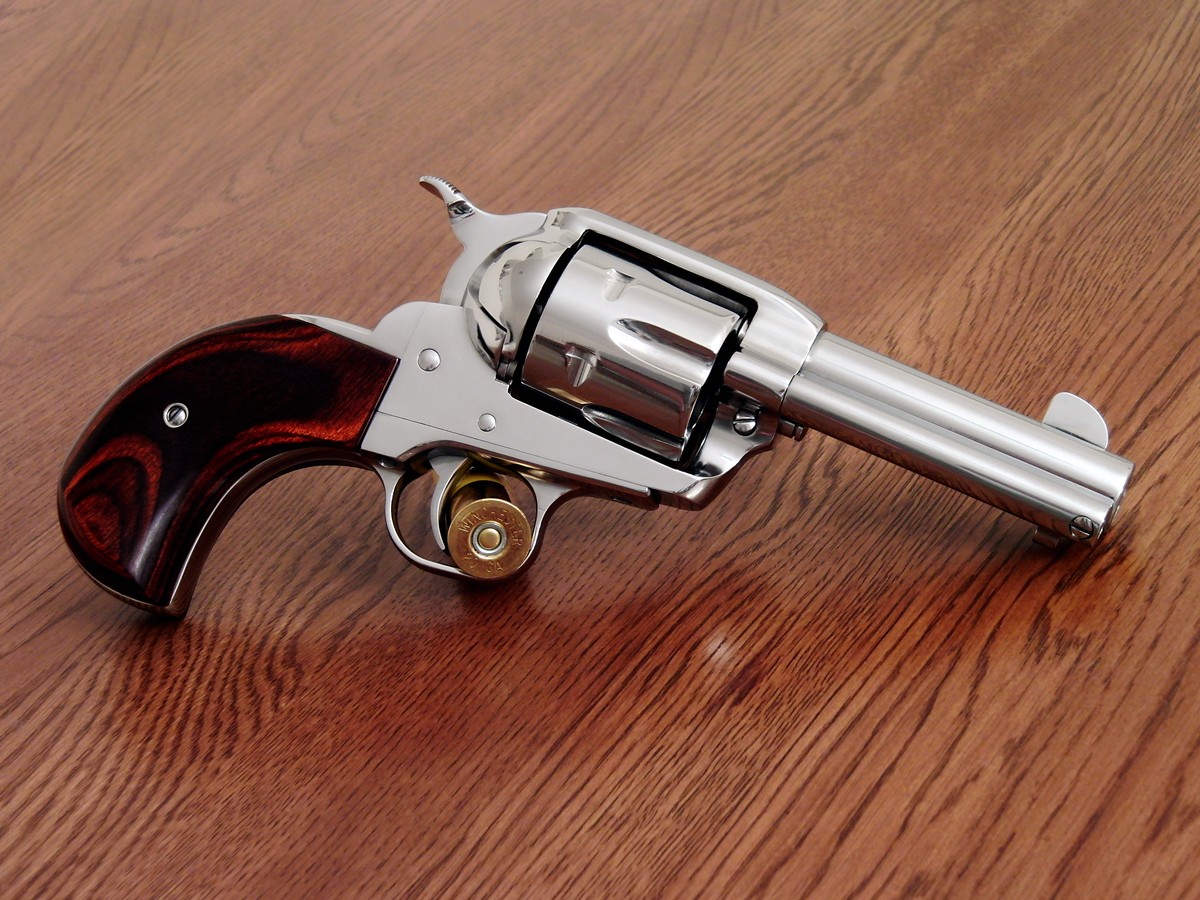
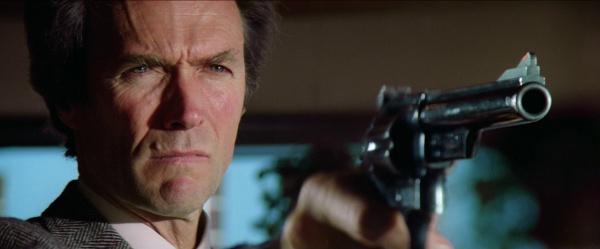
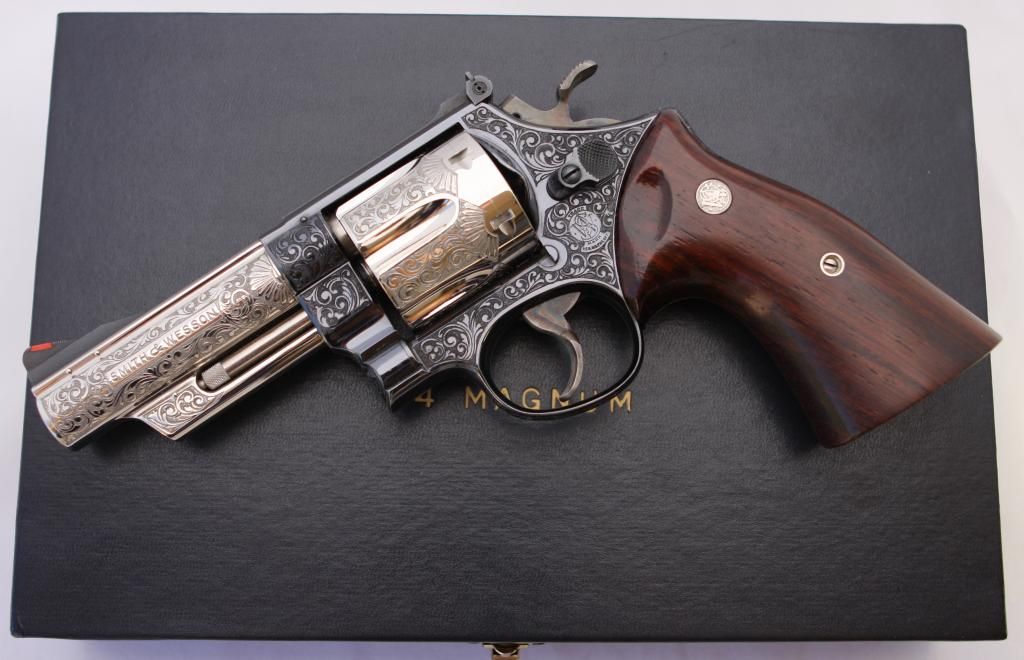
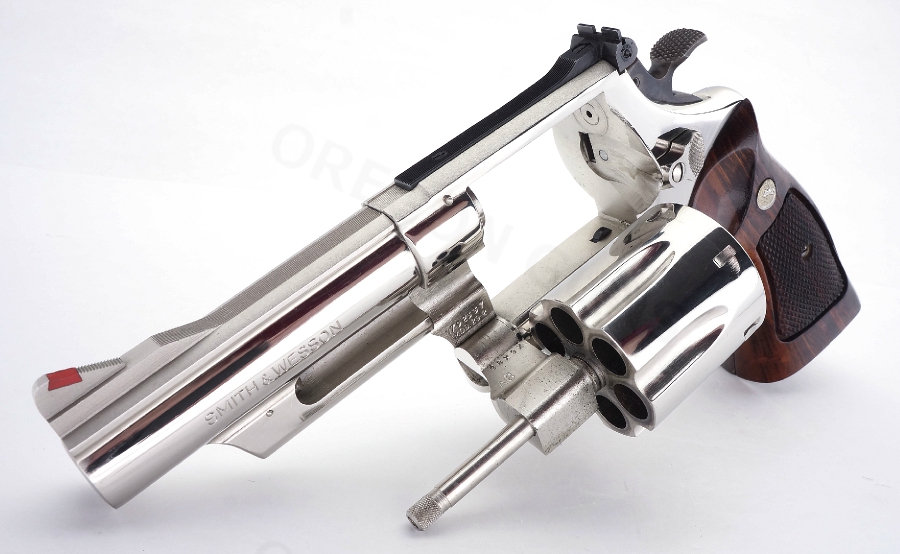
Yeah I know! “Go ahead and make my day!” I just knew that you were going to think that! Well here goes nothing.
I was first introduced to this Hand Cannon back in 1979 AD. When I got my first real job delivering Booze to the alcoholics from the local Liquor Store. (Thanks Ed & Dan for the chance you gave me!)
So when I got paid from that great job. I roared over to the local Gun Shop. Where the owner kindly let me do a layaway on a brand new Model 29 in Blue. Time then passed very slowly for me.
But the great day finally showed up and off I went with my new toy.
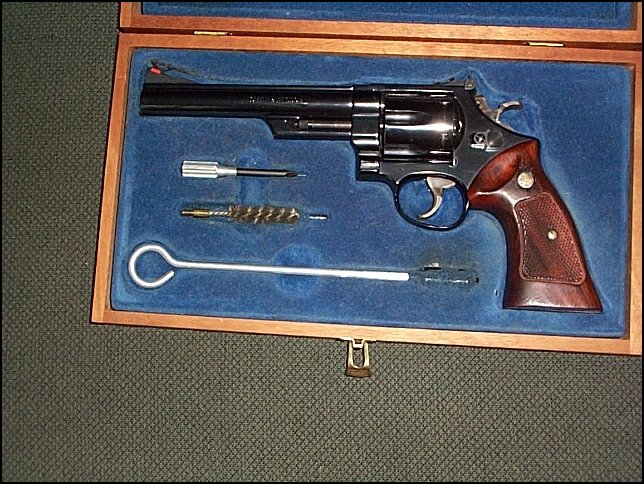
Back then S&W gave you a really nice Wooden Box to go with it. Even my Dad was impressed by it. So of course off I went to put it thru its paces.


Now at this time I had seen a few of the Dirty Harry Movies. So I was convinced that this piece was going to kick like a Missouri Mule.
To say that I was nervous would be a slight understatement. But really it was not bad at all. Since I had fired Dad’s Colt Commander in 45 ACP. Which frankly had a lot more felt recoil & report.

Now the place I shot at was owned by my Grandfather. Where was a old 50 gallon drum filled with rainwater. So being the dumb kid that I was. I put my first 6 rounds thru it.
What I found out was that this 6 inch monster would easily punch a hole in it. But would not punch an exit hole. Humph! But none the less it did produce a nice shock wave of water coming out of the barrel top.
Bottom line – It’s a keeper! In that whenever I go to the range. It gets a lot of attention. Especially when I crank off a full power Magnum round.
Also if you want to do some “normal” target shooting. You can not go too far wrong with the 44 Special. As I have seen it do some really spectacular patterns. Especially when my Son is shooting with it.
That & I would also feel sorry for a Bad guy being hit by one of these rounds. As it would no doubt do its duty. If you have done a proper shot placement that is.

Thanks for reading this!
Grumpy
Here is some more information below:
Smith & Wesson Model 29
| Smith & Wesson Model 29 | |
|---|---|
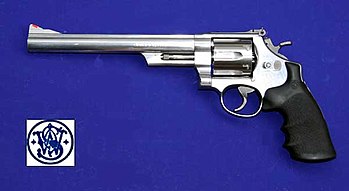
|
|
| Type | Revolver |
| Place of origin | United States |
| Service history | |
| Used by | See Users |
| Production history | |
| Manufacturer | Smith & Wesson |
| Produced | 1955–Present |
| Specifications | |
| Weight |
|
| Length |
|
| Barrel length |
|
|
|
|
| Cartridge | |
| Caliber | .429 in (10.9 mm) |
| Action | Double-action |
| Feed system | Six round cylinder |
| Sights | Open, adjustable rear |
The Smith & Wesson Model 29 is a six-shot, double-actionrevolver chambered for the .44 Magnum cartridge and manufactured by the U.S. company Smith & Wesson.
The Model 29 was offered with 3″, 4″, 5″, 6″, 6½”, 8⅜” and, later, 10⅝” barrel lengths as standard models. Other barrel lengths were available either by special order from Smith & Wesson’s Custom Shop or custom built by gunsmiths. The 5″ barreled variant had a full length underlug. Finish options available included a highly polished blued or nickel–platedsurface.
At the time of its introduction, the Model 29 was the most powerful production handgun. It was made famous by association with the fictional character “Dirty Harry” Callahan.
Contents
[hide]
Design[edit]
The Model 29 will chamber and fire .44 Special cartridges, as the .44 Magnum was developed from the .44 Special. The Magnum case is slightly longer to prevent magnum rounds from being chambered and fired in handguns chambered for the .44 Special.
History[edit]
Elmer Keith‘s achievements in maximizing the power and performance of the .44 Special was the inspiration and driving force behind the introduction of the .44 Magnum by Smith & Wesson. His intention for the new round was for it to be used in sidearms for hunters of large, dangerous game, rather than for self-defense, though with today’s specialty cartridges, it can be a good defensive round.[1]
S&W’s production of a large N-frame revolver in .44 Magnum began in 1955; the Model 29 designation was applied in 1957.[2]
At the time of its introduction, the Model 29 was the most powerful production handgun. There were a number of custom calibers that were more powerful, as in the old Howdah pistols of the 19th century.
It remained primarily the province of handgun enthusiasts, some law enforcement personnel and hunters until 1971, when Clint Eastwood made it famous as “the most powerful handgun in the world” in the movie Dirty Harry. After the movie’s release, retailers had trouble keeping the Model 29 in stock.[3]
In the late 1990s, Smith & Wesson discontinued production of many models of revolvers, including the ‘basic’ Model 29; since then, at various times, the model, in limited or ‘custom’ configurations, has been manufactured in as many as 10 evolutions.[4]
Variants[edit]
The original Model 29 was superseded by the Model 29-1 in 1960, with modifications made to the ejector-rod screw. The Model 29-2 replaced it the following year, with one screw that had secured the cylinder-stop spring being deleted. The barrel length was shortened from 6 1/2″ to 6″ in 1979. These two versions are known as “pinned and recessed”. “Pinned” means that the barrels are screwed in, and secured by a pin driven through the frame and a notch in the barrel. “Recessed” denotes the rear of the bored cylinder holes being countersunk, so that, when loaded, the cartridge rims are fully enclosed by the cylinder. In 1982, the cost-cutting Model 29-3 dropped recessed cylinders and pinned barrels for crush-fit barrels.[2]
The -4 and -5, produced from 1988 and 1990 respectively had changes to improve durability for heavy use. In 1994 the 29-6 began production, now fitted as standard with rubber Monogrips from Hogue to replace the previous wooden items, standard tapped holes also being provided for attaching scope mounts. The 29-7 started production in 1998 with changes to the locking mechanism, the firing pin’s attachment, and a hammer and trigger produced with a metal injection molding process.[2]
| Model | Start Year | Barrel Lengths | Modifications |
|---|---|---|---|
| 29 | 1957 | 6 1/2″ | |
| 29-1 | 1960 | 6 1/2″ | ejector rod screw |
| 29-2 | 1961 | 6 1/2″ changed to 6″ in 1979 | one screw that had secured the cylinder stop spring dropped |
| 29-3 | 1982 | dropped recessed cylinders and pinned barrels for crush-fit barrels | |
| 29-4 | 1988 | retention system on the yoke or cylinder crane strengthened, studs in frame were radiused; 8 3/8″ version offered with integral scope mts. | |
| 29-5 | 1990 | longer cylinder notches to prevent bolt jump, bolt and inner mechanism changed to reduce battering under recoil | |
| 29-6 | 1994 | standard with rubber Monogrips from Hogue | |
| 29-7 | 1998 | changes to the locking mechanism, the firing pin’s attachment, and a hammer and trigger produced with a metal injection molding process. | |
| 29-8 | 2001 | new frame design with internal lock | |
| 29-9 | |||
| 29-10 |
| Starting Number | Years |
|---|---|
| N1 | 1969-1972 |
| N100000 | 1973 |
| N200000 | 1974-1977 |
| N300000 | 1975-1976 |
| N400000 | 1977-1978 |
| N500000 | 1978-1980 |
| N600000 | 1979-1980 |
| N700000 | 1980 |
| N800000 | 1980-1983 |
| N900000 | 1982-1986 |
Model 629[edit]
Introduced in 1978, the Smith & Wesson Model 629 is a stainless steel version of the Model 29.
The 629 model designation derives from Smith & Wesson’s practice of denoting a stainless steel version of one of their already existing designs by placing a 6 in front of the model number of the original weapon. The 629 Classic variant features a full-length barrel underlug, other variants include the 629 Stealth Hunter.
| Model | Start Year | Barrel Lengths | Modifications |
|---|---|---|---|
| 629 | 1978 | ||
| 629-1 | 19xx | dropped recessed cylinders and pinned barrels | |
| 629-2 | |||
| 629-3 | |||
| 629-4 | |||
| 629-5 | Internal hammer added | ||
| 629-6 | Internal lock added |
Quiet Special Purpose Revolver[edit]
Some S&W model 29s were rebuilt by the AAI Corporation to make the Quiet Special Purpose Revolvers (QSPR). These had new, short, smoothbore barrels (35 mm / 1.375 inch), with .40″ / 10mm bore, with cylinder chambers reamed to accept special QSPR ammunition which externally resembled metal-cased .410-gauge shotgun shells but internally worked as a piston to trap the gases. This special ammunition was made by AAI.[5]
This pistol was developed from 1967 to 1971 to be used by tunnel rats in the Vietnam War. The QSPR was tested on the battlefield in 1969, and an improvement and testing program ran from 1970 until 1971. At least officially it never entered service. The US withdrawal from Vietnam reduced interest in the QSPR weapon, and the program ended in about 1972.[5]
A Russian handgun of more-recent vintage, the Ohs-38 Stechkin, is described as using a system virtually identical to that employed by the Quiet Special Purpose Revolver (QSPR).
Mountain Gun Variation[edit]
The Mountain Gun was introduced in 1989 as a lightweight version of the Model 29 designed to be “carried often and shot little”.[6] The barrel profile is a reprise of the original design. Early version 29-4 backpacker with 2.5″ barrel, (Very rare).
A Smith & Wesson Model 629 with a 3″ barrel called the “Trail Boss” was produced for the distributor, RSR.[7]
Other variants[edit]
- On January 26, 2006, Smith & Wesson announced the 50th Anniversary Model 29.[8] Identical to the previous models except for the gold inlaid trademark on the side cover, the new internal lock mechanism, and a non-fluted cylinder.
- On January 1, 2007, Smith & Wesson announced the reissue of the Model 29 as an engraved model in S&W’s Classics line.[9]
- The Smith & Wesson Model 629 Stealth Hunter has a 7.5″ ported barrel with a full-length under lug for increased stability and recoil reduction.The barrel-cylinder gap is 0.006 in (0.1524 mm), with a ball-detent lockup between the frame and cylinder crane that provides increased strength. The entire revolver is made of a stainless steel, with a glare-reducing matte black finish. It comes with slip-resistant synthetic grips.[10]
- The 329NG is a scandium-framed revolver with PVD-coated cylinder and tritium sights. It is part of the NightGuard line.[11]
In popular culture[edit]
The Model 29 became popular at gun stores following its use by the fictional character “Dirty Harry” Callahan from the Dirty Harry series of films starring Clint Eastwood.[3] It’s also prominently featured in the film “Taxi Driver” and the TV series “Sledge Hammer!“.
The Bren Gun

One of the only guns that I know of that had its own designed in mind vehicle. The Bren carrier

**Trigger Warning, Some serious bragging is coming up**
Now I have seen this machine gun a couple of times. Once at the Imperial War Museum in London. Where I was allowed to pick it up. Somebody trying to & did win a Victoria Cross in WWII Burma
At 22 pounds, I really feel sorry for the poor guy who had to hump this on a route march of any distance. The other time at a Machine Gun shoot at a very hot and nasty place.
From what I saw about it was that it was a pretty good squad machine gun for its time. Frankly I think that it was almost as good as the M-60 MG. That I served with in the Army.
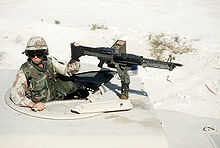
Now here is a couple of strange things that I noticed about it. Because the British / Commonwealth / Empire Army was stuck with the 303 Enfield Rimmed Round. It had to use and curved magazine that is mounted on top.
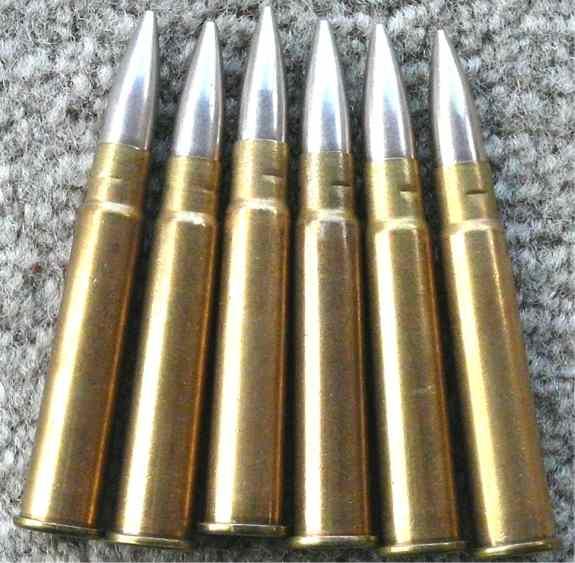 So when you cranked off a round. Gravity would help in both ejecting and feeding it another round. Pretty smart thinking says I.
So when you cranked off a round. Gravity would help in both ejecting and feeding it another round. Pretty smart thinking says I.

I am also willing to bet that it was mighty useful that both the Rifleman and the Bren Gunner used the same ammo. Always a good thing when high speed metal is flying around.
The other thing that struck me about this gun. Is the sight system that it uses. Because of the magazine blocks a straight view across the barrel. The sights have to be offset on the right hand side. 
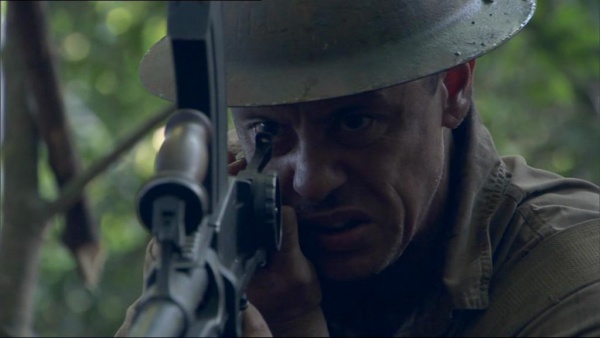
Now for some good news! First off way the Troops found that the Bren was too accurate! In that a good man could literally & consistently put a round thru the same hole. Again & again.
So a smart Trooper would hold on to a worn barrel. In order to get a better pattern when time came for suppressive fire.
Also after the war. The British Army wisely kept this gun inservice right up to the Falklands War in the early 1980’s. But wisely had it rebarreled in the 308 NATO round. I am told in this form it also gave the Crown great service. Notice the straight magazine compared to the earlier model. As the 308 round is rimless.
Notice the straight magazine compared to the earlier model. As the 308 round is rimless.
Here below is some more good stuff about this stout Warrior
WW2 Weapons: The Bren Gun

One of the most iconic British WW2 weapons today, the Bren Gun was in short supply in 1939 but quickly became the backbone of the British infantry.
by Arnold Blumberg
While all the combatant nations engaged in World War I fielded machine guns during the conflict, the British Army’s Vickers was arguably the best medium machine gun of the war, while their Lewis gun—an American design but perfected by the English—was the most effective light machine gun.
However, both weapons had their problems. The Vickers Machine Gun was a heavy Maxim-type weapon. Water-cooled and belt-fed, it was very reliable. But it was also a very complex war tool requiring a specially-trained crew, and the weight of the gun and the prodigious amount of water and ammunition it required meant the Vickers was restricted to a purely static defensive role.
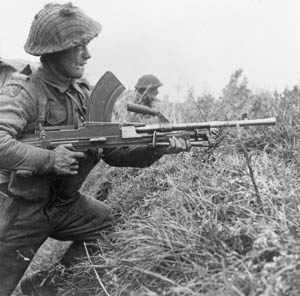
The Lewis gun had been adopted during the Great War to provide close support for advancing troops. It had an air-cooled barrel and fired .303 caliber bullets from a 47-round pan magazine mounted on the top of the piece. Unfortunately, the Lewis gun was still relatively bulky, complicated, suffered from a high rate of stoppages, and could not maintain sustained rates of fire due to its barrel overheating, causing the gun to simply stop working.
Replacing the Vickers & Lewis
Faced with the shortcomings of their standard medium and light machine guns, the British Army sought to replace both in the 1930s. That year, a contender to replace the Lewis gun appeared in the form of the Zb 26: a light, air-cooled, magazine-fed weapon produced by the Brno Firm of Czechoslovakia. Modified to shoot the standard British Army infantry and machine gun .303 caliber ammunition (or 7.7x56mm), the gun—now designated the Zb 30, with a 30 round curved magazine—caught the attention of the Small Arms Committee. After a few minor alterations, the Czech fire arm-called the ZBG 34, was adopted by the Army. Referred to as the BREN, from “Brno” and “Enfield”, assembly lines were set at the Royal Small Arms Factory in 1935, with the first finished product appearing in September 1937.
Introducing the Bren Gun
The original Bren gun was designated the Mark 1. It was capable of semi or fully automatic fire from a distinctive curved top-mounted 30-round magazine. It was 45.5 inches in overall length, and employed a quick-change 25-inch barrel, which could be replaced in seconds, allowing it to keep up a sustained rate of fire. The Bren gun used a magazine rather than the better belt-fed system due to the theory (proved incorrect by the Germans with their MG 34 and MG 42s) that the former made the weapon more portable. The piece weighed 22 pounds and 3 ounces, and fired 500 rounds per minute.
Throughout the Second World War, the Mark 1 Bren was modified three times to include the models Mark II, Mark III, and Mark IV. The same .303 caliber ammunition as the Mark 1 was used, so the differences between these patterns were a few pounds of weight and inches shaved off the later model’s overall length and barrels. In mid-1944, the Bren was standardized as the Mark III with a full length of 42.9 inches, barrel length 22.25 inches, and weighing 19 pounds and 5 ounces. Its effective range was 600 yards. It was essentially a lightened Mark 1, but fitted with a simpler ladder back sight of the Mark II, a shorter and lighter barrel (which reduced accuracy) and simpler butt. Over 57,600 Mark IIIs were produced during the war.
Backbone of the British Infantry
 During World War II, the Bren gun became the backbone of the British infantry. Every infantry section of ten men (equivalent to an American rifle squad) and its combat tactics were built around the Bren light machine gun, with the section’s riflemen tasked with augmenting the firepower of the Bren. Each infantry section contained a seven-man Rifle Group, and a three man Bren gun Group. In addition to carrying extra Bren gun ammunition, the Rifle Group would provide security and replacements for the Bren gun crews, while the Bren gunners provided the main killing power of the infantry section.
During World War II, the Bren gun became the backbone of the British infantry. Every infantry section of ten men (equivalent to an American rifle squad) and its combat tactics were built around the Bren light machine gun, with the section’s riflemen tasked with augmenting the firepower of the Bren. Each infantry section contained a seven-man Rifle Group, and a three man Bren gun Group. In addition to carrying extra Bren gun ammunition, the Rifle Group would provide security and replacements for the Bren gun crews, while the Bren gunners provided the main killing power of the infantry section.
In addition to the Bren in each infantry section, every infantry battalion included a carrier platoon made up of 13 Universal Carriers (unofficially called “Bren Gun Carriers”) in four sections of three vehicles each. Each conveyance carried a Bren gun and a three-man crew. Further, support units (ie,. supply, artillery) carried on their rosters Brens for close defense and anti-aircraft protection.
Bren guns were integral in anti-tank warfare. Although not able to knock a tank out with their small arms ammunition, their fire would cause the enemy tank crews to “button up,” limiting their fields of vision, and dispersing opposing infantry supporting the tanks. Anti-tank weapons could then be brought to bear on the steel monsters with less risk to the attackers.
Useful in the Far East and Western Front
When war broke out on September 1, 1939, the Bren had only been recently adopted by the British Army and was in short supply. After the British evacuation of France in June 1940, only 2,300 Bren guns were available for service. A chronic shortage of the weapon persisted until late 1942, when production of the gun by the UK, Canada, and Australia made up the shortfall. By war’s end Bren guns were in plentiful numbers with all British combat divisions: 1,262, 1,376, and 966 in infantry, armored, and airborne, respectively.
In the Far East, Commonwealth soldiers appreciated the Bren’s portability, as much of the fighting took place in swamps and the jungle and where the armament’s heavy caliber rounds could easily penetrate the thick vegetation. The Australians took to the Bren very quickly, using it as a heavy automatic rifle rather than a machine gun.
When the Allies landed in Italy in 1943, and then in France the next year, the Bren was not affected by the bitter winters found in those theaters of the war. More importantly, it allowed the British infantry, still equipped with bolt-action Enfield Rifles, to maintain a respectful rate of fire compared to the Americans’ use of the semi-automatic Garand Rifle, and the Wehrmacht’s employment of the excellent MG-42 Light Machine Gun.
The Bren gun, in its last incarnation—the post-World War II L4A4—was effectively removed from active service in the mid-1980s being replaced by the L86 Light Support Weapon. While never completely replacing the Vickers, the Bren did serve as the primary support arm for British and Commonwealth troops through World War II and Korea, and set the British small-unit infantry tactics on a path they would follow until the 1980s.
Originally Published January 20, 2015

Westley Richards .375 Bolt Action rifle built on original Oberndorf Magnum Mauser
____________________________________
Because I found some more Guns & Stuff That I want to add to the collection! ****By the way I do take tips from those so inclined to do so. My Paypal button is around here for those kind souls!****
Thanks
Grumpy
Here is some more!

GRANITE Mountain Arms 505 Gibbs-Ike Ellis.




F.N. Mauser – Custom – .270 Win caliber


Griffin & Howe – Mauser 98 Custom – .30-’06 caliber

Ruger Number 1 Highly Engraved

Custom pair of Westley Richards sidelock double rifles chambered in .470 Nitro Express. (God that must hit a shooter hard! Because look at its so called recoil pads)
The 92F Beretta 9mm

This is when you do not want to see a 92F!


Now I was basically phasing out of the Army National Guard. When “THE WORD” came down about the 1911a1 being replaced by the 92F.

To say that some of the Real Old Sweats were not happy. Would not really do them justice in describing their righteous rage.


But then after the survivors who said “maybe this might be a good thing”. Were either scrapped off the floor or gotten a Dust Off to the Medicos.
So We did like what all good soldiers do.
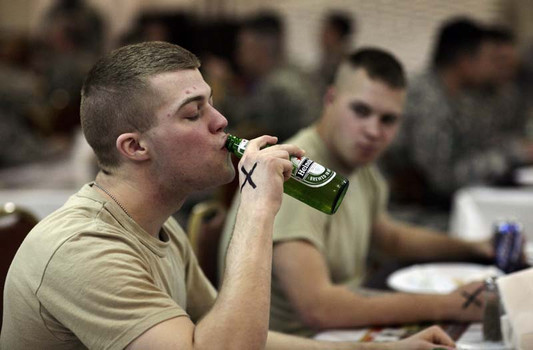
and then we.

Followed by almost stopping to complain about it for a while & continue the Mission.
Now here is what I found out. It is not that bad a pistol really. As I own one, (The price was too good to pass by the deal)
That & it seems to have the capacity to hold a huge amount of 9mm ammo. (15 rounds outside of the People’s Republic of California!)
Just do not tell that Jerk Mel Gibson about that. As it seems that he never has to reload in the movies.
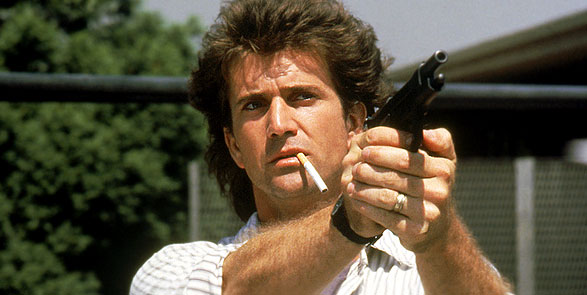
It also has some heft and shoot better at least to than the 45. I also like the sight picture. Here are some of the variations out there.

Now for the not so good news. The Trigger sucks in my humble opinion. Either in the single or double action mode. But maybe that is my problem.
Would I take this gun into a firefight by itself? Oh Hell no! Since I firmly believe that a pistol is really just a badge of rank. That & a gun of last resort.

If I could not avoid such a fight or not call in a strike.

Then I would take an AK-47 to the party.

But hopefully that will not happen again in mine or my family’s lifetime
Here is some more technical information about this fine pistol!
Beretta 92
| Beretta 92 | |
|---|---|
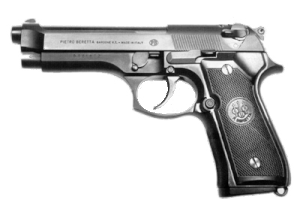
Beretta 92FS
|
|
| Type | Semi-automatic pistol |
| Place of origin | Italy |
| Service history | |
| In service | 1975—present |
| Used by | See Users |
| Production history | |
| Manufacturer | Fabbrica d’Armi Pietro Beretta |
| Produced | 1976—present |
| Variants | See Variants |
| Specifications | |
| Weight |
|
| Length |
|
| Barrel length |
|
|
|
|
| Cartridge |
|
| Muzzle velocity | 381 m/s (1,250 ft/s) |
| Effective firing range | 50 m (160 ft) |
| Feed system | Detachable box magazine:
|
The Beretta 92 (also Beretta 96 and Beretta 98) is a series of semi-automatic pistols designed and manufactured by Beretta of Italy. The model 92 was designed in 1972 and production of many variants in different calibers continues today.
The United States Armed Forces replaced the M1911A1 .45 ACPpistol in 1985 with the M9, a military spec Beretta 92FS.
Contents
[hide]
History[edit]
The Beretta 92 pistol evolved from earlier Beretta designs, most notably the M1923 and M1951. From the M1923 comes the open slide design, while the alloy frame and locking block barrel, originally from Walther P38, were first used in the M1951. The grip angle and the front sight integrated with the slide were also common to earlier Beretta pistols. What were perhaps the Model 92’s two most important advanced design features had first appeared on its immediate predecessor, the 1974 .380 caliber Model 84. These improvements both involved the magazine, which featured direct feed; that is, there was no feed ramp between the magazine and the chamber (a Beretta innovation in pistols). In addition, the magazine was a “double-stacked” design, a feature originally introduced in 1935 on the Browning Hi-Power.[1]
Carlo Beretta, Giuseppe Mazzetti and Vittorio Valle, all experienced firearms designers, contributed to the final design in 1975.[2]
Evolution[edit]
92[edit]
Production began in May 1976, and ended in February 1983. Approximately 7,000 units were of the first “step slide” design and 45,000 were of the second “straight slide” type.[3]
92S[edit]
In order to meet requirements of some law enforcement agencies, Beretta modified the Beretta 92 by adding a slide-mounted combined safety and decocking lever, replacing the frame mounted manual thumb safety. This resulted in the 92S which was adopted by several Italian law enforcement and military units.
92SB (92S-1)[edit]
The 92SB, initially called 92S-1, was specifically designed for the USAF trials (which it won), the model name officially adopted was the 92SB. Features added include a firing pin block (thus the addition of the “B” to the name), ambidextrous safety levers, 3-dot sights, and relocated the magazine release catch from the bottom of the grip to the lower bottom of the trigger guard. The later relocation of the magazine release button means preceding models (92 & 92S) cannot necessarily use later magazines, unless they have notches in both areas.[4]
A compact version with a shortened barrel and slide and 13-round magazine capacity known as the 92SB Compact was manufactured from 1981 to 1991.[4]
92F (92SB-F)[edit]
Beretta modified the model 92SB slightly to create the 92SB-F (the “F” added to denote entry of the model in U.S. Government federal testing) by making the following changes:
- Design of all the parts to make them 100% interchangeable to simplify maintenance for large government organizations.
- Squared off the front of the trigger guard so that one could use finger support for easier aiming.
- Recurved the forward base of the grip to aid aiming.
- Hard chromed the bore to protect it from corrosion and to reduce wear.
- New surface coating on the slide called Bruniton, which allegedly provides better corrosion resistance than the previous plain blued finish.[5]:16
The French military adopted a modified version of the 92F with a decocking-only lever as the PAMAS G1. These pistols have Tellurium in the slide, making the steel brittle and as such only have a service life of approximately 6,000 rounds. [1]
92FS[edit]
The FS has an enlarged hammer pin that fits into a groove on the underside of the slide. The main purpose is to stop the slide from flying off the frame to the rear if it cracks. This was in response to reported defective slides during U.S. Military testing.[6]
Design[edit]
The Beretta 92’s open slide design ensures smooth feeding and ejection of ammunition and allows easy clearing of obstructions. The hard-chromed barrel bore reduces barrel wear and protects it from corrosion. The falling locking block design provides good accuracy and operability with suppressors due to the in-line travel of the barrel. This is in contrast to the complex travel of Browning designed barrels. The magazine release button is reversible with simple field tools. Reversing the magazine release makes left-handed operation much easier.
Increasingly, it has become popular to reduce handgun weight and cost as well as increase corrosion resistance by using polymers. Starting around the year 2000, Beretta began replacing some parts with polymer and polymer coated metal. Polymer parts include the recoil spring guide rod which is now also fluted, magazine floor plate, magazine follower and the mainspring cap/lanyard loop. Polymer coated metal parts include the left side safety lever, trigger, and magazine release button.[7]
Magazines[edit]
To keep in line with the introduction of laws in some locations restricting magazines that hold more than 10 rounds, Beretta now manufactures magazines that hold fewer than the factory standard 15 rounds. These magazines have heavier crimping (deeper indentations in the side) to reduce the available space while still keeping the same external dimensions and ensuring that these magazines can be used on existing firearms. Beretta also produces 15 round “Sand Resistant” magazines to resolve issues encountered with contractor made magazines, and 17 round magazines included with the A1 models. Both magazines function in earlier 92 series and M9 model pistols.
Italian magazine manufacturer Mec-Gar now produces magazines in blue and nickel finishes with an 18-round capacity, which fit flush in the magazine well on the 92 series. Mec-Gar also produces an extended 20-round blued magazine that protrudes below the frame by 3⁄4 inch (19 mm). These magazines provide users in unrestricted states with a larger capacity magazine.
Variants[edit]
The Beretta 92 is available in many configurations and models:
Trigger systems[edit]
- FS Models
- The FS models are Double-action/Single-action (DA/SA) pistols; they have an initial double-action trigger pull subsequently followed by single-action operation. The “FS” models have a safety lever that also functions as a decocking lever.
- G Models
- The G models (so named because this configuration was first designed for the French “Gendarmerie“) feature a decocking lever only instead of the safety-decocking lever of the FS. When the decocking lever is released, it automatically returns to the ready-to-fire position. There is no manual safety.
- DS Models
- The DS models are double action only pistols: the hammer doesn’t stay cocked. Therefore the hammer spur has been removed, and is flush with the rear of the slide. The safety levers serve as manual safeties only and have no decocking feature..
- D Models
- The D models are also double-action only pistols but without the manual safeties.
Models[edit]
- 90Two
- (2006-2012)
- The 90two is a 9mm/.40 variant of the 92-series with a redesigned, thicker slide and frame with an accessory rail, captive recoil spring, internal recoil buffer, replaceable sights, user changeable monogrips and 17-round magazines.[8]
- 92A1 / 96A1
- (2010–present)
- The 92A1 and 96A1[9] were introduced in 2010, based on elements from the 92FS and 90two. The overall shape and styling builds on the 92FS with more parts commonality than the 90-two had. From the 90-two comes a heavier slide construction combined with a slightly altered frame to accommodate the picatinny rail and .40 S&W power levels. While most internal components are compatible with standard 92 models, the slide, frame, captive recoil spring assembly, and takedown lever and button of the 92A1 and 96A1 are not interchangeable with other models other than the 90-two.
- 92G-SD / 96G-SD
- (2002-2005, 2015-)
- The 92G-SD is a tactical variant of the 92G with a Brigadier slide and picatinny rail.
- 96FS
- (1990-2008)
- Variant chambered for the .40 S&W, Succeeded by the 96A1.
- 98F
- Variant chambered for 9×21mm IMI. This option was introduced in 1987 for markets where it is illegal to own a weapon chambered for a military cartridge such as 9×19mm; essentially, this is the case of Italy. There were also about 5000 early 98F manufactured in 7.65×21mm Parabellum.
- Billennium
- (2001)
- A limited-edition (2000 copies) commemorative (of the year 2000) model manufactured in 2001, featuring the heavier Brigadier slide. Only 1000 Billennium pistols were initially imported into the United States, the other 1000 were sold throughout the rest of the world. The Billennium also has a frame mounted safety.
- Brigadier
- (1993–present)
- 60-gram (2.1 oz) heavier slide and 1 millimetre (0.039 in) wider to improve control when firing multiple shots in quick succession. It also includes removable front and rear sights.
- CB
- (1992–1993)
- Single action only. It is designed for sport shooting and includes a front barrel bushing for improved accuracy.
- Centennial
- (2015)
- The 92 FS Centennial limited edition (500 units) commemorates adoption by the Italian Military of Beretta’s earliest semiautomatic pistol, the Model 1915. This Centennial 92 is notable for its frame-mounted manual safety and single-action-only mechanism. The Beretta medallion in each wood grip panel displays the anniversary dates in Roman numerals, which are also engraved on either side of the steel slide. The pistol is packaged in a custom M2A1 ammunition can bearing the Centennial logo.[10][11]
- Centurion
- (1992–2004)
- Shorter barrel and slide (like “Compact”), but with standard-sized frame that has a slightly shorter dust cover. Special G Centurion, DS Centurion and D Centurion models are available in some countries.
- Combat
- (1994–2001)
- Heavier Brigadier slide, single-action only and also designed for sport shooting, including a front barrel bushing for improved accuracy. It also came with an additional longer barrel that was weighted.
- Compact L
- (1992–present)
- Shorter barrel, slide, and more compact frame (13-round magazine capacity).
- Compact M
- (1992–2004)
- Similar to the Compact L, but has a slimmer grip that accepts only a single stacked 8-round magazine.
- Compact with Rail
- (present)
- A compact version of the M9A1.
- Elite I
- (1999–2001)
- Pistols with this option include the heavier Brigadier bruniton slide with front serrations and Elite designation, Inox finish (silver) stainless barrel, thin skeletonized hammer, and bevel of the magazine well. A flat hammer spring cap was standard as well as the decock only (G-Model) feature and dovetailed front sight. It was introduced in 1999 and replaced by the Elite II option in 2001.
- Elite IA
- (2001)
- This option is essentially a black Vertec with a bruniton Brigadier G slide having the Elite 1A designation and a thicker skeleton hammer. The 4.7 in (120 mm) stainless barrel with Inox finish was also changed to the blackened stainless version like black Vertecs.
- Elite II
- (2001)
- This option replaced the Elite I option in 2001 and includes the same features as the original Elite plus removable Novak type sights, extended magazine release catch, checkered front/rear grip strap, thicker (than Elite I) skeletonized hammer, and lighter D-spring. This option is available only with the stainless G-Model slide, also with front serrations. The stainless barrel for the Elite II has a target crown.
- Inox
- (present)
- The Inox models feature the following parts made in stainless steel: the barrel, the slide (including the extractor, the safety and the right-side manual safety lever), the trigger, the trigger pin, and slide stop lever. The aluminum frame is anodized to match the color. Can have either black or stainless controls.
- M9
- (1990-present)
- The M9 is essentially the commercial 92FS as the design was when it was adopted by the US military in the late 1980’s. Subtle differences from a modern production 92FS are a straight dustcover, “snowman” style sights, a straighter grip and military markings.
- M9A1
- (2006-present)
- The M9A1 was adopted by the USMC in 2006. It adds a 1-slot Picatinny rail, more aggressive front and backstrap checkering and a beveled magazine well for easier reloading of the weapon. M9A1 pistols are sold with physical vapor deposition (PVD) coated magazines developed to better withstand the conditions in the sandy environments in Iraqand Afghanistan.[12]
- M9A3
- (2015-present)
- The M9A3 (the M9A2 concept never went into production) was released in 2015 as part of the Modular Handgun System trials. The main updates to the M9A3 were a 3-slot Picatinny rail, thinner vertical grip, removable wrap-around grips that can be swapped between Vertec-style and ‘old’ M9 style[13], fully removable sights and a universal slide, which makes the gun convertible from decocker-safety to decocker-only mode. Additionally, the M9A3 comes with 17-round sand-resistant magazines in a beveled shape for easier reloading.
- Steel I
- (2004)
- Nickel-plated carbon steel, single-action-only, collector’s model. [Edit: Both single-action-only and single/double-action variants exist. Also used for competitive shooting because of its steel frame (for added weight and strength), the frame-mounted safety and/or Vertec-style grip-frame that are all desirable features in a competition gun.]
- Stock
- (1994–present)
- Heavier Brigadier slide. It is also designed for sport shooting and includes a front barrel bushing for improved accuracy.
- Vertec
- (present)
- Thin Vertec polymer grips, flush muzzle with slide, and dovetail target sights. Late models have an underbarrel 92A1-style Picatinny accessory rail.
- Wilson Combat 92G Brigadier Tactical
- (2014 to present)
- Made in collaboration with Wilson Combat,[14] these pistols differ from the standard Brigadier in that they have a military standard 1913 picatinny rail, all steel controls (as opposed to the polymer coated steel), decock only feature (G-model), 4.7″ target crowned barrel, fluted steel guiderod, thin profile G-10 grips, rounded trigger guard, the lighter hammer spring used in the “D” model, Elite II hammer, and their own unique serial number with a “WC” prefix among other features.
93R machine pistol[edit]
The Beretta 93R is a significantly redesigned 92 to provide the option of firing in three-round bursts. It also has a longer ported barrel, heavier slide, fitting for a shoulder stock, a folding forward grip, and an extended magazine. Unlike other Berettas in the 90 series it is single-action only, does not have a decocker, and very few are around today.[5]:12–13
Copies[edit]
The Beretta 92 was designed for sports and law enforcement use and, due to its reliability, was accepted by military users in South America and other countries all over the world.
- Brazil
- A large contract for the Beretta 92 was with the Brazilian army, for which Beretta set up a factory in Brazil. This factory was later sold to the Brazilian gunmaker Taurus (Forjas Taurus S/A). Taurus makes pistols called PT92without the need for a license from Beretta since their design is based on the original Beretta 92, whose patents have since expired.
- The PT92 can be distinguished from its modern Beretta counterpart primarily by having the safety mounted on the frame as opposed to on the slide like the Beretta. Though mechanically similar to the original, the PT92s differ from the early 92s by having a trigger guard similar to the modern 92s (the originals were rounded) and a magazine release in the same place as the modern 92s (the originals were at the bottom of the grip).
- Turkey
- Turkish companies MKEK and Girsan manufactured a copy of the Beretta 92F as Yavuz 16 for the Turkish Armed Forces and General Directorate of Security.[15][16] There has been speculation that these were being made under contract from Beretta. Some of these pistols were imported into the United States by the company American Tactical Imports as the American Tactical 92 or AT-92. Yavuz 16 was exported to Canada, Colombia, Georgia, Malaysia and Syria.[17]
- France
- France has made licensed copies of Beretta 92FS as the PAMAS G1 and the French-M92 is now in use in the Armies and law enforcement agencies, only to be replaced by the SIG SP2022 in the national police.
- Taiwan
- Taiwan had made Beretta-like pistols namely the T75 Pistol.
- South Africa
- South Africa had produced the Beretta under license since 1992 as the Vektor Z88, and the batches are used by the South African Police.
- Egypt
- Egypt had produced the Beretta 92 under license as the Helwan 920 with the magazine release button at the bottom of the magazine.[18]
Users[edit]
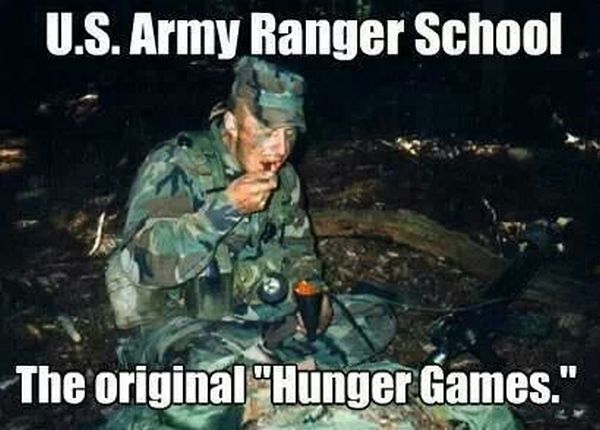





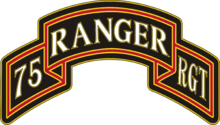















 Email This Post
Email This Post Print This Post
Print This Post







